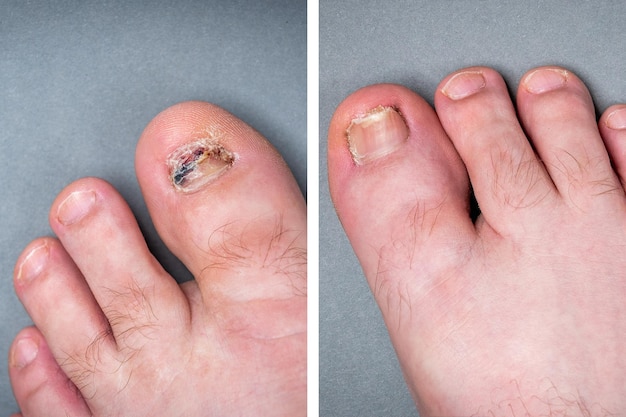Find out “What Are 3 Signs of A Fungal Nail Infection?” Fungal nail infections, medically known as onychomycosis, are a common condition that affect millions of people worldwide. They occur when fungi, such as dermatophytes, invade the nails, causing various unpleasant symptoms. If left untreated, fungal nail infections can lead to discomfort, pain, and even more severe complications. In this article, we will explore the three signs that indicate the presence of a fungal nail infection and provide insights into diagnosis, treatment, and prevention.
Having healthy nails is not only aesthetically pleasing but also an indicator of good overall health. However, fungal nail infections can disrupt the natural appearance and structure of nails, leading to significant concerns. Recognizing the signs of a fungal nail infection is crucial in order to seek appropriate treatment promptly.
See Also | Acai Berry Nutrition: Vitamins, Minerals, and Benefits
Table of Contents
- 1 Understanding Fungal Nail Infections
- 1.1 What are fungal nail infections?
- 1.2 Causes of fungal nail infections
- 1.3 Common risk factors
- 1.4 Thickened nails
- 1.5 Discoloration of nails
- 1.6 Brittle or crumbly nails
- 1.7 Nail separation
- 1.8 Foul odor
- 1.9 Diagnosis of fungal nail infections
- 1.10 Over-the-counter treatments
- 1.11 Prescription medications
- 1.12 Preventive measures
- 2 Home Remedies and Natural Treatments
- 3 Preventing Fungal Nail Infections
- 4 Final Note
- 5 FAQs
Understanding Fungal Nail Infections

What are fungal nail infections?
Fungal nail infections are caused by the overgrowth of fungi in the nails, commonly affecting the toenails rather than the fingernails. The fungi responsible for these infections are typically found in warm and moist environments, such as public showers, gyms, or swimming pools. When the nails are exposed to these fungi, an infection can occur, leading to the development of various symptoms.
Causes of fungal nail infections
Fungal nail infections can be caused by different types of fungi, including dermatophytes, yeast, and mold. These organisms thrive in warm and humid conditions, making certain environments more conducive to their growth. Factors such as poor nail hygiene, weakened immune system, diabetes, aging, and wearing tight shoes for extended periods can increase the risk of developing fungal nail infections.
Common risk factors
Several factors can increase the likelihood of developing a fungal nail infection. These include:
1. Age: Older individuals are more susceptible to fungal infections due to decreased blood circulation and slower nail growth.
2. Poor circulation: Conditions like diabetes or peripheral arterial disease can impair blood flow, making it harder for the body to fight off infections.
3. Nail trauma: Injuries to the nail bed or surrounding skin can create openings for fungi to enter and cause an infection.
4. Signs and Symptoms of Fungal Nail Infections
Fungal nail infections can manifest in various ways, and recognizing the signs and symptoms is essential for early detection and treatment. Here are three common indicators of a fungal nail infection:
Thickened nails
One of the primary signs of a fungal nail infection is nail thickening. Infected nails may become noticeably thicker than usual, making them difficult to trim or maintain. The thickening is a result of the fungi invading the nail bed and causing structural changes. Over time, the nails may become increasingly brittle and prone to cracking or breaking.
Discoloration of nails
Another characteristic symptom of a fungal nail infection is the discoloration of the affected nails. Infected nails often exhibit yellow, brown, or white patches, spots, or streaks. As the infection progresses, the discoloration may spread across the entire nail, giving it a discolored, unsightly appearance. Discoloration may also occur in the form of a greenish-black color.
Brittle or crumbly nails
Fungal nail infections can cause the nails to become brittle and crumbly. The infected nails may easily chip, flake, or break, leading to a rough and uneven texture. This fragility is due to the weakening of the nail structure caused by the fungal invasion. Brittle and crumbly nails can also make the nails more susceptible to further damage and secondary infections.
Nail separation
In some cases, a fungal nail infection can cause the affected nail to separate from the nail bed. This condition is known as onycholysis and is characterized by the detachment of the nail from its natural position. As the infection progresses, the nail may lift and create a gap between the nail and the nail bed. This separation can lead to discomfort, pain, and an increased risk of secondary bacterial infections.
Foul odor
Fungal nail infections can also produce a foul odor. The presence of fungi in the nails can result in the release of unpleasant smells. The odor is often described as musty or pungent and may become more noticeable when the nails are wet or after prolonged periods of wearing closed-toe shoes.
It is important to note that these signs and symptoms may vary in severity depending on the individual and the extent of the infection. If you suspect a fungal nail infection, it is advisable to seek medical diagnosis and appropriate treatment.
4. Seeking Medical Diagnosis and Treatment
When experiencing signs of a fungal nail infection, it is crucial to consult a healthcare professional for an accurate diagnosis and proper treatment. The healthcare provider will evaluate the symptoms, examine the affected nails, and may conduct tests, such as nail clippings or cultures, to confirm the presence of a fungal infection.
Diagnosis of fungal nail infections
The diagnosis of a fungal nail infection typically involves a physical examination and the assessment of the nail’s appearance. The healthcare provider may also inquire about the patient’s medical history and any underlying conditions that could contribute to the infection. In some cases, laboratory tests may be performed to identify the specific type of fungi causing the infection.

Over-the-counter treatments
For mild or early-stage fungal nail infections, over-the-counter antifungal treatments can be effective. These treatments often come in the form of topical creams, ointments, or nail polishes that contain antifungal agents such as clotrimazole or terbinafine. It is important to follow the instructions provided and continue the treatment for the recommended duration to achieve the best results.
Prescription medications
In more severe cases or when over-the-counter treatments prove ineffective, healthcare providers may prescribe oral antifungal medications. These medications, such as itraconazole or fluconazole, work from within the body to eliminate the fungal infection. They are typically taken for a specified period, and it is crucial to follow the prescribed dosage and duration to ensure the complete eradication of the infection. It is worth noting that oral antifungal medications may have side effects and interactions with other medications, so it is essential to discuss any existing medical conditions or medications with the healthcare provider before starting treatment.
Preventive measures
Prevention plays a significant role in avoiding fungal nail infections or preventing their recurrence. Here are some preventive measures you can take:
-
Keep your feet clean and dry: Wash your feet daily with soap and water, paying particular attention to the spaces between your toes. Dry your feet thoroughly, especially after bathing or swimming.
-
Wear breathable footwear: Choose shoes made from breathable materials, such as leather or mesh, to allow proper airflow and reduce moisture buildup. Avoid wearing tight, closed-toe shoes for extended periods.
-
Avoid sharing personal items: Do not share socks, shoes, or nail clippers with others, as this can increase the risk of spreading fungal infections.
-
Protect your feet in public areas: Use flip-flops or sandals when walking in public showers, locker rooms, or pool areas to minimize contact with potentially contaminated surfaces.
Home Remedies and Natural Treatments
In addition to medical treatments, certain home remedies and natural treatments may help manage fungal nail infections. While these remedies may not provide a complete cure, they can be used as complementary approaches or preventive measures. It is important to consult with a healthcare professional before trying any home remedies, especially if you have underlying health conditions or are taking medications.
Tea tree oil
Tea tree oil has antifungal properties and is often used in the treatment of fungal infections. Dilute tea tree oil with a carrier oil, such as coconut or olive oil, and apply it to the affected nails. This natural remedy may help inhibit the growth of fungi and reduce symptoms. However, it is important to use tea tree oil with caution, as it can cause skin irritation in some individuals.
Vinegar soak
Soaking the affected nails in a mixture of vinegar and water is another popular home remedy for fungal nail infections. The acidity of vinegar creates an unfavorable environment for fungi to thrive. Mix equal parts of vinegar and warm water in a basin or tub, and soak the affected nails for 15-20 minutes daily. Pat the nails dry thoroughly afterward.
Essential oils
Certain essential oils, such as lavender oil or oregano oil, have antifungal properties and can be used as topical treatments for fungal nail infections. Dilute the essential oil with a carrier oil and apply it to the affected nails. These oils may help reduce the growth of fungi and alleviate symptoms. However, it is important to do a patch test before using essential oils, as they may cause skin irritation in some individuals.
Proper nail hygiene
Maintaining proper nail hygiene is essential in preventing and managing fungal nail infections. Trim your nails regularly, keeping them short and straight across. Avoid biting or picking at the nails, as this can create openings for fungi to enter. Use clean and disinfected nail clippers and avoid sharing them with others. Additionally, make sure to thoroughly dry your nails after washing or bathing, paying attention to the spaces between the toes.
Preventing Fungal Nail Infections
Prevention is key when it comes to fungal nail infections. By following these preventive measures, you can significantly reduce the risk of developing an infection:
-
Keep your feet clean and dry: Wash your feet daily with soap and water, and dry them thoroughly, especially between the toes.
-
Wear moisture-wicking socks: Opt for socks made of breathable materials, such as cotton or wool blends, that can absorb moisture and keep your feet dry.
-
Choose breathable footwear: Select shoes made from breathable materials that allow air circulation and minimize moisture buildup. Avoid wearing tight or non-breathable shoes for extended periods.
-
Alternate your shoes: Give your shoes time to dry out by alternating between different pairs. This helps prevent a damp environment that can promote fungal growth.
-
Use antifungal powders or sprays: Apply antifungal powders or sprays to your feet and inside your shoes to help kill any fungi present and prevent infection.
-
Avoid walking barefoot in public areas: Wear flip-flops or sandals in public showers, locker rooms, and pool areas to reduce the risk of coming into contact with fungi.
-
Don’t share personal items: Avoid sharing socks, shoes, towels, or nail clippers with others to minimize the risk of spreading fungal infections.
-
Maintain proper nail hygiene: Trim your nails regularly, keeping them short and clean. Avoid biting or picking at your nails, as this can create openings for fungal infection.
By incorporating these preventive measures into your daily routine, you can significantly reduce the likelihood of developing a fungal nail infection.
See Also | Mango: 8 Potential Health Benefits of Mango Leaves
Final Note
Fungal nail infections can be uncomfortable, unsightly, and persistent if left untreated. Recognizing the signs and symptoms is crucial in order to seek appropriate medical diagnosis and treatment. Whether opting for over-the-counter remedies, prescription medications, or home remedies, it’s important to follow the recommended treatments consistently to effectively eliminate the infection.
Prevention is equally important in avoiding fungal nail infections. By practicing good foot hygiene, wearing breathable footwear, and taking precautions in public areas, you can reduce the risk of fungal infections and maintain healthy nails.
If you suspect a fungal nail infection or have concerns about your nail health, consult with a healthcare professional for an accurate diagnosis and tailored treatment plan.
FAQs
A: Yes, fungal nail infections can spread to other nails, skin, or even other parts of the body if left untreated. It is important to address the infection promptly to prevent its spread.
A: The duration of treatment for a fungal nail infection can vary depending on the severity and individual response to treatment. It can take several weeks to months for the infection to clear completely.
A: Yes, fungal nail infections can be contagious. They can spread through direct contact with infected nails or by sharing personal items such as nail clippers or shoes.
A: Nail polish can create a favorable environment for fungal growth by trapping moisture. It is advisable to avoid using nail polish during the treatment of a fungal nail infection.
A: While mild cases of fungal nail infections can be treated with over-the-counter remedies, it is recommended to consult a healthcare professional for proper diagnosis, especially for persistent or severe infections.
Continue to check our website for more articles of this kind. And, please use our comment section as well, we would love to hear from you.









